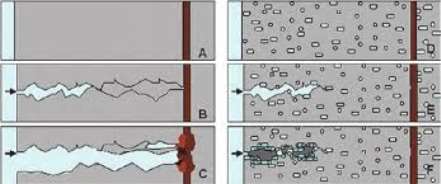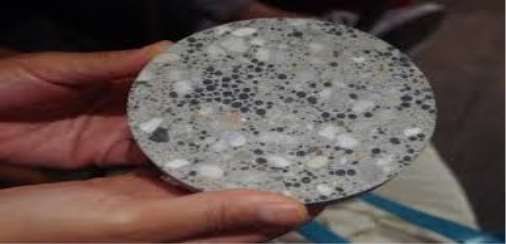Individual and Combined Healing Techniques Experiment
| ✅ Paper Type: Free Essay | ✅ Subject: Engineering |
| ✅ Wordcount: 1563 words | ✅ Published: 30 Aug 2017 |
Smart materials:
The materials that have one or more properties that can be changed in a controlled way by an external stimuli such as heat, light, pressure, electric field etc.
Examples:
Piezoelectric: these materials produce a voltage when stress is applied
Magnetic shape memory: these materials change their shape in response to magnetic field
PH sensitive polymers: these materials change their volume with change in their surrounding ph.
Chromogenic systems: these materials change their color with thermal, opticall and electrical changes
Temperature responsive polymers: these materials change their behavior with change in temperature.
- and many more as Smart inorganic polymers, Halo chromic,Ferro fluid,Photomechanical materials, Self-healing materials, Magneto caloric materialsetc.
Smart materials in construction industry:
since the dawn of humanity, having a proper place to live under has been the prime need of humans, to tackle this the humans have started building shelters using natural available materials.wiht the passage of time the human being evolved and their requirementsincreased, and a new era of construction begin in which they combined utilizedscientific methods to build huge sky scrapers of different shapes and heights.
In the twentieth century to achieve certain automated functions and artificial intelligent systems, certain materials that could decide on their own in limited ways were developed. Since then aloof research has been done in this field and it has also been utilized in construction industry in manyways I-e
It is used in windows to automatically close and open in response to light and temperature, it is also used in rooms electric control systems to switch on and off depending on the requirements,
It is used in central cooling and central heating system to control the room temperature.it is also used in concrete to introduce certain qualities,
Self healing concrete:
The concrete that fix its own crack is called the self healing concrete
Introduction:
Concrete is a core building material. But even concrete starts to crumble when it comes face-to-face with water, wind, stress and pressure. it is the world’s most usable material since 2000 years when then romans built pantheon.and the durability of the concrete has always been under question.since centuries a lot of money, effort and time spent in repairing concrete structures.
different types and different of concrete has been tested and utilised,but the issue of cracking hasn,t been solved yet,which reduces the life span of the concrete.
The current method of dealing with structural instability in concrete has been to replace or repair it. But what if all you had to do was add a little water? A new type of smart concrete.
A concrete that could heal itself and work well till its service life.
Types:
There are two types of self-healing concrete:
- bending concrete
- bio concrete
Bending concrete:
They consist of polymer fiber thick as human hairs.
They are 40% lighter in weight.
They are 500 times more resistant to cracking
Bio concrete:
Bio concrete consist of concrete mix with bacteria called extremophiles.
When a crack occurs in the concrete, the bacteria actively produces lime, thus healing the cracks.
Mechanism of self healing concrete:
Mineral producing bacteria has been found that could help heal micro cracks inconcrete. since 2006 at the Civil Engineering and Geosciences Faculty in Delft A healing agent that activates when certain bacteria added in the concrete convert nutrients into limestone has been under development.

The science behind self-healing concrete
The project team have investigated individual and combined healing techniques in the laboratory and at the field-scale. The individual healing techniques address damage at various lengths and timescales. These include encapsulating healing agents, bacterial healing agents, and crack closure using shape memory polymer tendons and repeated supply of healing agents through vascular networks.
We explore how these work in a bit more detail below:
Healing agents – small grain sized ingredients areused as healing agents. These capsules are termed as microcapsules. Once the concrete sets the capsules are in dormant condition unless a crack is formed and it ruptures releasing the materials that fills the gap and recovers it. The mechanism stops the entrance of other substances and thus strengthens it.
Bacterial action – A solution containing self-healing bacteria is mixed within the concrete mix. In their trails scientists used different types of self-healing bacteria. But the bacteria bacillus pseudofirmus mixed with light weight aggregates in the form of pearlites worked the best.
Memory polymer tendons – Memory polymers have also the healing capability to close any cracks that results later after exposure. In a trial these polymers were manufactured into ‘tendons’ tied onto the reinforcement .these could be activated by a heating wire system.
Repeated supply of healing agent through vascular networks – Artificial channels were strategically placed within concrete structures through which healing agents could be supplied under pressure.
By combining all the above mentioned mechanics the healing efficiency of the concrete could be increased.
Preparation of bacterial concrete:
We have two methods:
- direct application
- encapsulation in light weight concrete
Direct application:
In this method,while making the concrete, the bacteria and its food calcium lactate are mixed with the mixture.
In this process when a crack occurs the bacteria pores break and the bacteria gets active and feeds on calcium lactate and as a result limestone is produced.
Encapsulation method:
This method is expensive however effective.in this method bacteria and its food, calcium lactate are formed into pellets and then these pellets are mixed into the concrete. About 6% of bacteria is used in making self-healing concrete.
When a crack is formed in the concrete the pellets are broken and the bacteria is released and then the bacteria starts its healing action and thus the cracks are recovered.
Testing of bacterial concrete and its result:
Sample:
In this test concrete disks are prepared by mixing porousaggregates, bacteria and its food to make a self-healing concrete disks. The samples are cured for 56 days.
Tests performed on samples:
Tensile test: deformation tensile controlled splitting test is performed on the disks.
Permeability test: after cracking of the disks, the concrete is place in permeability setup in which water is applied at one end for 24 hours.

Test results:
After cracking and permeability test, the cracks were healed and the results were obtained.
The result showed that the healing of the bacterial concrete was far greater than normal concrete.
UK’s first trial of self-healing concrete:
this is a university led project in which the different types of self healing concretes are tested.
The project is named “entitled materials for life”.in this project three separate self-healing technologies will be used for the first time in real world setting.
The overall aim of the Cardiff-led project is to develop a single system that can be embedded into concrete when it is initially set, and then automatically sense when damage occurs. Once damage is detected, the system will be able to repair itself autonomously without the need for human intervention
The first technique is using shape shifting materials, called shape memory polymers, which are used to repair large concrete cracks.
In the technique, both inorganic and organic bacteria will be injected through thin tunnels into the concrete to fix the cracks.
In the third technique, tiny capsules containing bacteria and its food will be embedded in the concrete, so when a crack occurs in concrete the capsules will collapse and heal the cracks.
In this research, the researchers have cast six concrete walls, each containing different technology. The team will load the concrete at different angles to induce cracks at different positions and then measure how effective each of the applied technique is.
Advantages:
- Theself-healing concrete reduces the maintenance and the repair costs of the reinforced concrete structures.
- Oxygen is the main cause of the corrosion of steel in reinforced structures, the bacteria present in self-healing concrete mixture reduces the corrosion of the steel.
- It can be used for the maintenance of places and structures where the human accessibility is dangerous or impossible I-e- underwater structures, dams, tunnels etc., thus reducing the human losses in construction industry.
- The crack will be repaired in its initial stages, so the life of the building will increase, making it more sustainable.
Disadvantages:
- If the volume of the bacteria is increased than 20% in self-healingconcrete, the strength of the concrete reduces.
- It is still in beginner stages, that’s why no wide spread use have.
- Bacteria and calcium lactate are the two main ingredients of the self-healingconcrete, and making of calcium lactate from milk is costly, thus making the self-healing concrete cost double that of conventional concrete.
- Not practically used in real life buildings, that’s why people are reluctant to its use.
- Skilled labour is required
Applications:
Self-healing concrete can be used in sectors such as
- Marine structures
- Underground retaining walls
- Highway bridges
- Basement walls
- Concrete flooring
- Tunnel lining
Conclusion:
Self-healing concrete, is still at its initial development stage and vast research is required in this area, because it is not easily achievable and is costly which makes it difficult to use.
But with all its cons it have some good attributes such as self-healing and corrosion reducer. it is an effective and smart material which if further research is carried on, can be the future of concrete structures, enhancing the life span and strength of concrete structures.
References:
National building specifications (NBS)
Delft university/structural department/research articles/webredactie
Cardiff university research journal
www.concrete.org.uk
Cite This Work
To export a reference to this article please select a referencing stye below:
Related Services
View allDMCA / Removal Request
If you are the original writer of this essay and no longer wish to have your work published on UKEssays.com then please click the following link to email our support team:
Request essay removal


